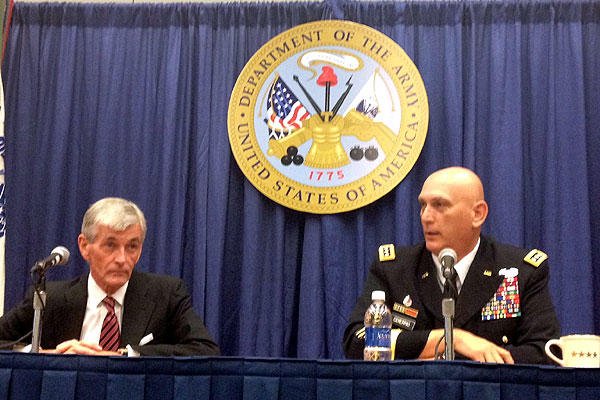U.S. Army leaders are preparing for the worst-case budget scenario, unsure whether Congress will act to avert automatic cuts known as sequestration, the service's top civilian said.
Army Secretary John McHugh has directed officials to prepare two budgets for fiscal 2015; one that assumes the across-the-board spending reductions remain in effect and one that doesn't. He made his remarks during the first day of an annual conference organized by the Association for the United States Army, an Arlington, Va.-based advocacy and educational group.
"I wish I could tell you better days lie ahead," McHugh told a crowd during the opening ceremony. "Sadly, I can't."
The Defense Department faces about $500 billion in automatic cuts through 2021. That's in addition to almost $500 billion in reductions already included in 2011 deficit-reduction legislation. The first installment totaled about $37 billion and began March 1 after lawmakers were unable to reach an alternative agreement on taxes and spending. The second installment totals about $52 billion and is set to take effect Jan. 1.
The largest branch of military service is downsizing amid the financial pressures and the winding down of the U.S.-led wars in Iraq and Afghanistan.
The Army already plans to shrink from more than a half a million active-duty soldiers today to about 490,000 around 2017. That figure, however, may drop to 380,000 if sequestration remains in effect, Pentagon officials have said. The pace of the reductions have led some to question whether the ground force will be able to perform its full range of contingency operations.
"We happen to believe a smaller but well equipped, highly trained Army is better able to meet contingencies than say a large force without sufficient training, without modern equipment," McHugh said.
The financial challenge of sequestration and recent government shutdown has hurt the Army's ability to prepare and train for war, McHugh said. Many Humvees, Bradley infantry fighting vehicles and M1 Abrams tanks sit idled, and some soldiers haven't qualified to shoot standard-issue M4 rifles because of training delays, he said.
In a separate briefing with reporters, Army Chief of Staff Gen. Raymond Odierno said of the 42 active duty brigade combat teams, the Army only has two trained for combat missions. The service wants to increase that number to seven by June, he said. Soldiers deploying to Afghanistan are being trained to advise and assist Afghan forces, not engage in combat, he said.
McHugh criticized the political impasse on Capitol Hill that resulted in the first government shutdown since the mid-1990s. About 165,000 Army civilians were temporarily forced to take mandatory leaves of absence, known as furloughs, and the closure was estimated to cost the service about $150 million, he said.
"We were forced to rob Peter to pay Paul and then Paul got furloughed," he said.
McHugh also criticized Congress for relying on short-term funding measures, known as continuing resolutions, rather than full-year budgets to fund the government. The practice is costly and inefficient because the Army can't develop new programs or fund new priorities, he said.
In a sign of the pessimism that is pervading long-term budget planning, the Army is also preparing a five-year spending projection that assumes the automatic cuts remain in effect, McHugh said.
"While we continue to hope for relief, prudence requires that we plan for the other," he said.


























